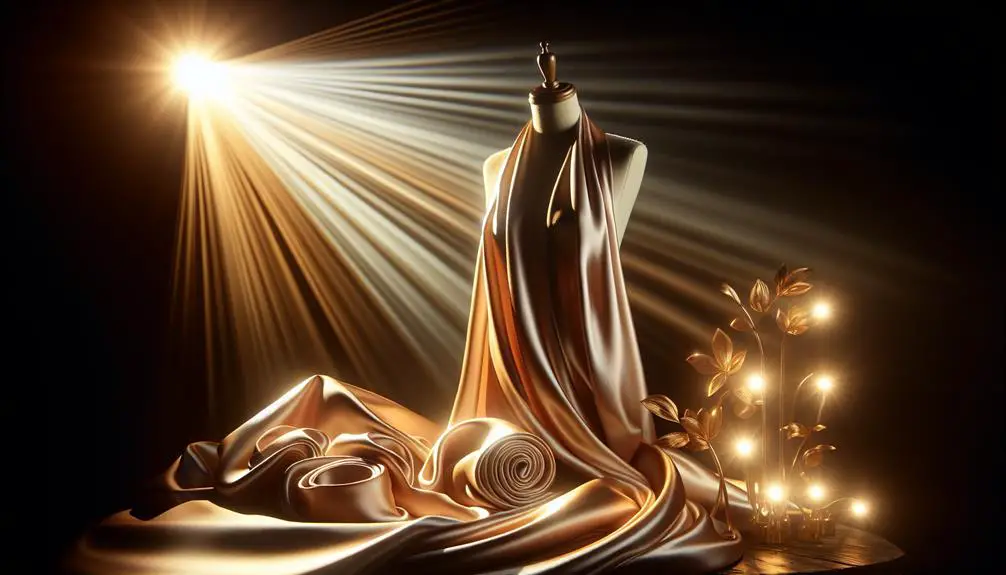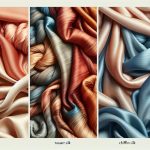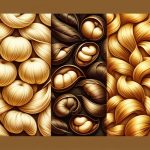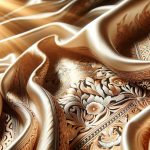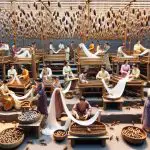Silk fabric embodies sophistication and luxury, originating from ancient China and crafted by silk moths. Known for its strength, sheen, and elegance, it's the strongest natural fiber. The intricate production process involves rearing silkworms and careful weaving. Types like Mulberry, Eri, and Muga offer unique qualities. Silk fabric finds use in high-end fashion and home goods, prized for its hypoallergenic and durable nature. While eco-friendly, some concerns exist about production ethics. Certifications, like Silk Mark and USDA, guarantee quality and sustainability. Unravel the world of silk fabric for a deeper understanding of its rich history and diverse applications.
Table of Contents
Key Takeaways
- Silk fabric is a luxurious textile derived from silk moth larvae.
- Known for its luster, strength, and natural sheen.
- Produced by carefully cultivating silkworms and weaving their silk threads.
- Used in high-end fashion, home furnishings, and accessories.
- Offers benefits like hypoallergenic properties and excellent moisture absorption.
Origin of Silk Fabric
Silk fabric, with its roots dating back to ancient China in the Neolithic period, holds a significant place in the history of textiles. This luxurious material is derived from the cocoons of silk moths, particularly the larvae of the mulberry silkworm. The production of silk is a fascinating process that involves the careful cultivation of these insects undergoing complete metamorphosis.
For centuries, Chinese silk was a closely guarded secret, with silk production remaining exclusive to China. However, the opening of the Silk Road in the latter part of the 1st millennium BC facilitated the spread of this exquisite fabric to other parts of the world, leading to its widespread popularity and cultural significance.
Silk fabric, as a natural fiber, symbolizes elegance and luxury. Its journey from ancient China to distant lands along the Silk Road has embedded it with historical importance and enduring allure. The intricate process of silk production and the craftsmanship involved in creating this fabric contribute to its timeless appeal.
Silk Fabric Characteristics
Characterized by its luster, strength, and durability, silk fabric stands out as a natural fiber with luxurious appeal and historical significance. Its unique characteristics make it a sought-after material in high-end fashion and home furnishings. Here is a table highlighting the key characteristics of silk fabric:
| Characteristic | Description |
|---|---|
| Luster | Silk has a natural sheen that adds an elegant touch to garments and textiles. |
| Strength | Despite its delicate appearance, silk is one of the strongest natural fibers, making it durable and long-lasting. |
| Durability | Silk fabric is resilient and can withstand wear and tear, maintaining its quality over time. |
Understanding these characteristics helps in appreciating the value and versatility of silk fabric in creating exquisite pieces that exude sophistication and luxury.
Silk Fabric Production Process
I'll now introduce the process of silk fabric production.
Silk fabric is meticulously crafted through the intricate process of rearing silkworms and weaving the delicate threads they produce.
This ancient technique requires precision and skill to create the luxurious fabric known for its smooth texture and natural sheen.
Silk Worms
The process of creating silk fabric begins with the harvesting of cocoons from the mulberry silkworm larvae. Silkworms produce silk threads by secreting a protein called fibroin, creating strong and lustrous fibers.
To extract the silk, cocoons are softened in hot water, allowing the silk threads to be carefully unraveled. These threads are then spun into yarn for weaving into luxurious silk fabric.
The intricate process of silk production showcases the natural beauty and durability of this sought-after material. Through centuries, silk fabric made from silkworms has been treasured for its exquisite qualities, making it a symbol of elegance and sophistication in the world of textiles.
Silk Weaving
After harvesting cocoons from the mulberry silkworm larvae, the process of silk weaving commences by unwinding silk threads to create yarn. This yarn is then twisted together to form a durable and shiny material that's ready for further processing.
To guarantee the quality of the silk, the cocoons undergo heating to prevent the worms from emerging, allowing for uninterrupted thread extraction. Post-production processes such as dyeing, bleaching, and additional treatments are carried out to improve the properties of the silk yarn.
Types of Silk Fabric
When it comes to silk fabric, various types offer unique characteristics and origins.
Mulberry Silk stands out for its fine quality, while Eri Silk provides a cruelty-free alternative.
Exploring the diversity of silk fabrics reveals a world of textures and colors that cater to different preferences and needs.
Silk Types Overview
Exploring the diverse world of silk fabric reveals a range of types, each with unique characteristics and origins. Mulberry silk stands out as the most widely produced silk globally, known for its fine quality.
Eri silk, also called peace silk, is distinguished by its heavy and durable nature, making it a popular choice.
Tasar silk, a wild silk variety native to India, holds the position as the second-most produced type, valued for its strength.
Spider silk, though mainly used for industrial purposes due to its strength, is significantly expensive.
Muga silk, a semi-domesticated silk produced exclusively in Assam, India, boasts a distinctiveness that sets it apart in the world of silk fabrics.
Popular Silk Varieties
Mulberry Silk, known for its fine quality and luxurious feel, is the most widely produced type of silk fabric globally.
Eri Silk, also known as peace silk, is a heavy and durable silk variety often preferred for upholstery and heavy-duty garments.
Tasar Silk, originating from India, is the second most produced silk fabric, esteemed for its unique texture and appearance.
Spider Silk, though costly, finds its main application in industries due to its exceptional strength and elasticity.
Muga Silk, exclusively cultivated in Assam, India, stands out for its semi-domesticated nature and prized natural golden color with a beautiful sheen.
These diverse silk varieties play pivotal roles in the silk industry, contributing to the creation of exquisite silk textiles and garments and enriching the silk trade.
Characteristics of Silk
Silk fabric exhibits a wide range of characteristics that make each type unique and valuable in various industries and applications. This natural fiber is known for its luxurious feel and lustrous appearance.
Different types of silk, such as Mulberry Silk, Eri Silk, Tasar Silk, Spider Silk, and Muga Silk, vary in their tensile strength and environmental impact. Mulberry Silk, the most common type, is prized for its strength and smooth texture. Eri Silk, also called peace silk, is heavy and durable, while Tasar Silk is known for its rich texture and deep color.
Spider Silk, despite its high cost, is exceptionally strong and used in specialized industries. Muga Silk, unique to Assam, India, is semi-domesticated and valued for its golden hue in Chinese culture.
Uses of Silk Fabric
How can silk fabric be incorporated into various aspects of modern fashion and design?
Silk fabric is highly sought after in the world of high-end fashion and couture design due to its luxurious feel and elegant drape. It's commonly used in creating luxury garments such as evening gowns, suits, blouses, and ties. Additionally, silk fabric is a popular choice for home furnishings like bedding, curtains, and decorative pillows, adding a touch of sophistication to interior decor.
The versatility of silk fabric allows for its use in a wide range of clothing items, from flowing dresses to tailored suits, showcasing its adaptability in fashion design. When caring for silk garments, it's essential to hand wash them in cold water with mild detergent, avoiding direct sunlight during drying to maintain the fabric's sheen and integrity.
The benefits of silk fabric, including hypoallergenic properties, body temperature regulation, moisture absorption, durability, and eco-friendliness, make it a desirable choice for those seeking both luxury and sustainability in their fashion and home decor choices.
Environmental Impact of Silk Fabric
The environmental impact of silk fabric production varies depending on the methods used and the locations where silk is cultivated and processed. Silk is generally considered sustainable and eco-friendly as a natural fiber. Wild silk, in particular, has no negative environmental impact as it's harvested without harming the silkworm. However, the cultivation and transportation of silk can have adverse effects on the environment, especially if chemical inputs and intensive farming practices are involved. On the bright side, producing silk from mulberry trees is relatively clean as these trees don't require chemical pesticides or fertilizers.
Despite its eco-friendly reputation, it's important to mention that some countries may exploit workers in the silk production process, leading to social and ethical concerns. Therefore, when considering the environmental impact of silk fabric, it's crucial to evaluate not only its cultivation and processing methods but also the social aspects of its production to guarantee a truly sustainable approach.
Certifications for Silk Fabric
Certifications play an essential role in ensuring the quality and sustainability of silk fabric. Various organizations provide certifications such as Silk Mark in India, USDA in the United States, and the European Union for silk produced in Europe. These certifications guarantee that the silk meets rigorous standards for quality assurance and sustainability. By obtaining these certifications, silk producers demonstrate their commitment to providing high-quality and eco-friendly products to consumers.
To understand the significance of certifications for silk fabric, let's take a closer look at some of the key certifying bodies:
| Certification Body | Location | Focus |
|---|---|---|
| Silk Mark | India | Quality Assurance |
| USDA | United States | Quality Standards |
| European Union | Europe | Organic Certification |
These certifications not only assure the quality of silk but also emphasize the importance of sustainable practices in the silk industry. Customers can trust products with these certifications to be both high in quality and environmentally friendly.
Frequently Asked Questions
What Does Silk Cloth Symbolize?
Silk cloth symbolizes luxury, elegance, and sophistication. It has been associated with royalty and high social status. The shimmering effect and softness of silk contribute to its symbolic significance in various cultures, embodying refinement and wealth.
What Is Silk Fabric Made For?
I love silk fabric for its versatility – it's used in clothing like scarves, lingerie, and eveningwear, as well as in home decor like pillows and curtains. It's even employed in industrial applications for making parachutes and surgical sutures.
What Is Silk and Why Is It Important?
Silk, a natural protein fiber, is essential for its luster, strength, and luxury status. Its significance lies in global trade, high-end fashion, and eco-friendly properties. Care involves hand washing, avoiding sunlight, and ironing gently.
Why Is Silk a Special Fabric?
Silk holds a special place for its luxurious luster, strength, and history of global trade. Its intricate production process and durability make it a coveted fabric in high-end fashion and home furnishings, embodying elegance.
- How Does Ring Spun Cotton Affect Garment Fit and Shape Retention? - August 13, 2024
- What Are the Challenges in Producing Ring Spun Cotton? - August 13, 2024
- Is Ring Spun Cotton Suitable for Plus-Size Clothing? - August 13, 2024

